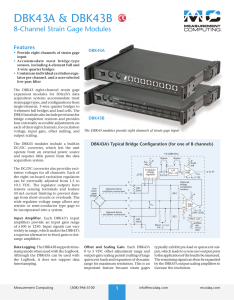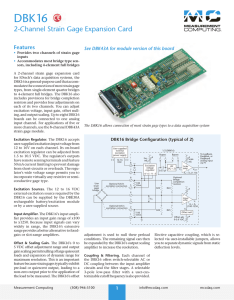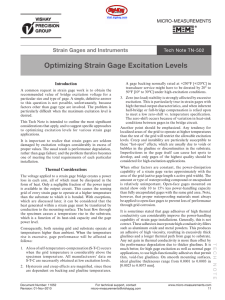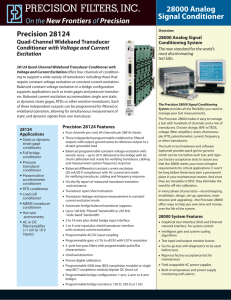a AN-532 APPLICATION NOTE
advertisement
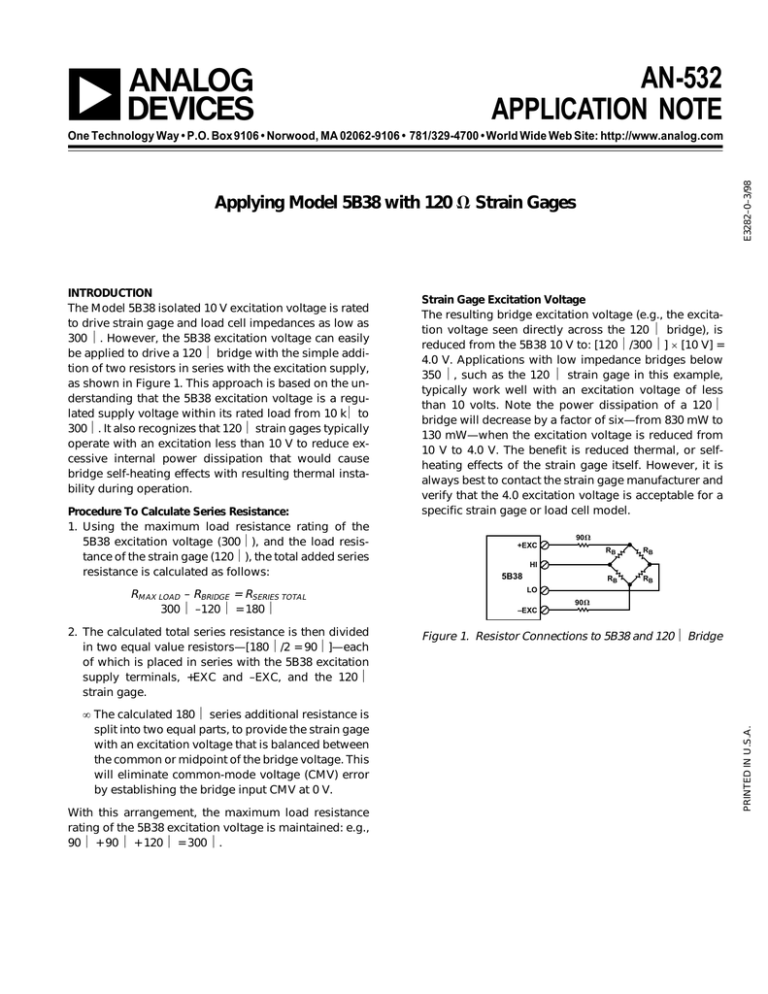
a AN-532 APPLICATION NOTE E3282–0–3/98 One Technology Way • P.O. Box 9106 • Norwood, MA 02062-9106 • 781/329-4700 • World Wide Web Site: http://www.analog.com Applying Model 5B38 with 120 V Strain Gages Procedure To Calculate Series Resistance: 1. Using the maximum load resistance rating of the 5B38 excitation voltage (300 Ω), and the load resistance of the strain gage (120 Ω), the total added series resistance is calculated as follows: RMAX LOAD – RBRIDGE = RSERIES TOTAL 300 Ω –120 Ω = 180 Ω 2. The calculated total series resistance is then divided in two equal value resistors—[180 Ω/2 = 90 Ω]—each of which is placed in series with the 5B38 excitation supply terminals, +EXC and –EXC, and the 120 Ω strain gage. • The calculated 180 Ω series additional resistance is split into two equal parts, to provide the strain gage with an excitation voltage that is balanced between the common or midpoint of the bridge voltage. This will eliminate common-mode voltage (CMV) error by establishing the bridge input CMV at 0 V. With this arrangement, the maximum load resistance rating of the 5B38 excitation voltage is maintained: e.g., 90 Ω + 90 Ω + 120 Ω = 300 Ω. Strain Gage Excitation Voltage The resulting bridge excitation voltage (e.g., the excitation voltage seen directly across the 120 Ω bridge), is reduced from the 5B38 10 V to: [120 Ω/300 Ω] × [10 V] = 4.0 V. Applications with low impedance bridges below 350 Ω, such as the 120 Ω strain gage in this example, typically work well with an excitation voltage of less than 10 volts. Note the power dissipation of a 120 Ω bridge will decrease by a factor of six—from 830 mW to 130 mW—when the excitation voltage is reduced from 10 V to 4.0 V. The benefit is reduced thermal, or selfheating effects of the strain gage itself. However, it is always best to contact the strain gage manufacturer and verify that the 4.0 excitation voltage is acceptable for a specific strain gage or load cell model. 90V +EXC RB RB RB RB HI 5B38 LO 90V –EXC Figure 1. Resistor Connections to 5B38 and 120 Ω Bridge PRINTED IN U.S.A. INTRODUCTION The Model 5B38 isolated 10 V excitation voltage is rated to drive strain gage and load cell impedances as low as 300 Ω. However, the 5B38 excitation voltage can easily be applied to drive a 120 Ω bridge with the simple addition of two resistors in series with the excitation supply, as shown in Figure 1. This approach is based on the understanding that the 5B38 excitation voltage is a regulated supply voltage within its rated load from 10 kΩ to 300 Ω. It also recognizes that 120 Ω strain gages typically operate with an excitation less than 10 V to reduce excessive internal power dissipation that would cause bridge self-heating effects with resulting thermal instability during operation.
